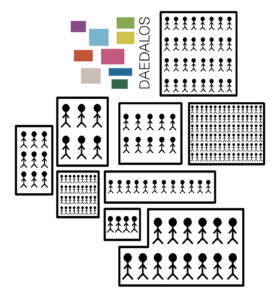Principal Investigator
Prof. Maud Devolder
Ignited by my first experience as an archaeology student in a Belgian Medieval cathedral, my research focuses on the detailed and dynamic study of architectural remains as a way to understand ancient building practices and the societies that commissioned and experienced monuments. With this two-fold interest for ancient architecture and societies at heart, I have developed a strong hands-on experience with the Aegean architectural record throughout my Ph.D. (“Social Components and Interactions in Neopalatial Crete (1700-1450 BCE). An Investigation of the Archaeological Data”, 2009) and post-doctoral research in several institutions in Europe (2010-2021), complemented by extensive fieldwork. A focus on the Minoan architectural record has provided me with an ideal field of research for developing pioneering approaches, including the estimation of the labour-time invested in Aegean vernacular and elite edifices. This creative attitude towards the built environment is fed by my dynamic involvement in archaeological projects and the direction under the aegis of the French School at Athens of the study and publication of the Minoan Palace at Malia. This key position has made it possible for me to develop and test alternative investigations of specific aspects of construction, such as itinerant craftspeople and the impact of local vernacular building practices on palatial architecture. I have also kept expanding my interests and field experience in a wider geographical and chronological framework through my collaborative work on cut-stone architecture in the broader Eastern Mediterranean Bronze Age, as well as my involvement in the study of the Classical and Hellenistic quarries in Delphi.
- Role in the project: Overall coordination ; Data processing in Aegean and Cypriot Bronze Age architecture ; Data analysis ; Conceptualisation of architectural patterns
- More info and bibliography: academia.edu UGent
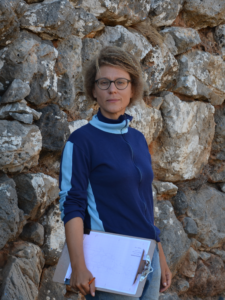
Team members
Dr. Lieselot Lapon
I completed a Master of Arts in Archaeology at Ghent University, focusing on the urban development of early medieval Flanders (2008). I then pursued a Master’s in Geography with a specialisation in Geomatics and Socio-Economic Geography (2008-2010). After a year at the Flemish Heritage Agency (Onroerend Erfgoed), I joined Ghent University’s Department of Geography as a project collaborator, where I worked on educational initiatives, including the development of school atlases, the organisation of GIS and land surveying workshops, and participation in a UNESCO project on remote sensing in the Caribbean. In 2015, I began a PhD in cartography, exploring global-scale cognitive mapping through a worldwide study. By designing a user-friendly test that allowed people to estimate the surface proportions of countries and continents, I investigated the influence of various factors (including education, map projections, place of living, and age) on the development of mental maps. From 2019 to 2024, I led the educational team at BOS+, an environmental organisation, before returning to archaeology. My current role within DAEDALOS brings together my expertise in archaeology and geography.
- Role in the project: Geomatics analysis in Aegean Bronze Age architecture
- More info and bibliography: Link coming soon.
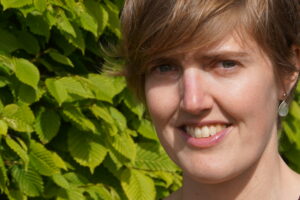
Dr. Marco Prete
Coming to archaeology (MA, PhD) from a history background (BA), my research focuses on the socio-political and economic dynamics of Crete between the third and second millennia BCE. I am particularly interested in developing a robust methodological framework that integrates diverse physical evidence and analytical techniques to explore the meanings embedded in material culture. My early research involved an island-wide comparison of architectural and artefactual evidence from major Cretan sites (2017-2020). During this period, I took part in the Curatorial Project of the British School at Athens at the Knossos Research Centre, gaining valuable technical skills in analysing a wide range of archaeological finds. For my PhD at the University of Catania (2020-2024), I combined traditional material cultural studies with GIS analysis (QGIS, GRASS GIS) to examine socio-political and economic dynamics in the underexplored Pediada region (north-central Crete) across different spatial and temporal scales. Since 2019, I have been involved in the Galatàs Pediada project, where I am responsible for publishing the finds excavated in buildings of the settlement and in the palatial complex, in collaboration with Dr. G. Rethemiotakis and Dr. K. Christakis.
- Role in the project: Data analysis in Aegean Bronze Age architecture
- More info and bibliography: Link coming soon.
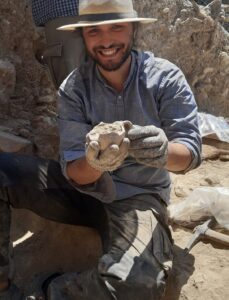
Dr. Marialucia Amadio
I specialise in integrated micromorphological approaches to studying occupation deposits and building materials with the aim of exploring the social aspects of the built environment in Mediterranean prehistoric contexts. I was awarded a Ph.D. by the University of Reading for a thesis on “Architecture and Urbanisation in Bronze Age Cyprus: local and regional innovation in material, technology and social representation” (2017), after which I was awarded postdoctoral fellowships at the Department ofHumanistic Studies of the University of Torino (Italy) and at the Kimmel Centre for Archaeological Science—Weizmann Institute of Science (Israel). During this period, I worked on the application of multiscalar interdisciplinary analyses to the investigation of technological and social aspects related to the production of building materials, floor sequences and the use of space in prehistoric Cypriot contexts. Afterwards, I spent two years as a postdoctoral fellow at the Department of Civilisation and Forms of Knowledge in the University of Pisa (Italy), with a project aimed at analysing abandonment sequences in key Middle Bronze Age contexts in Cyprus and exploring the social significance of the abandonment processes identified in order to shed new light on the transformative social environment of this period on the island.
- Role in the project: Data processing in Cypriot and Aegean Bronze Age architecture
- More info and bibliography: UGent academia.edu
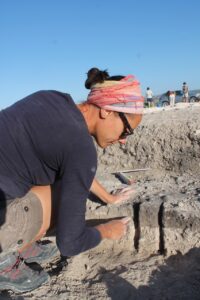
Dr. Eleni Christaki
I specialise in the study and documentation of architectural elements and building techniques of the monumental edifices in Bronze Age Crete, as well as in the management of archaeological data for prehistoric sites using geographical information systems. After a Master’s in Geotechnologies applied to Archaeology in the University of Siena I obtained a Ph.D. in Prehistoric Archaeology from the National and Kapodistrian University of Athens with a project on “Architectural Elements and Construction Techniques of the Neopalatial Buildings. Methodology for Managing and Documenting Archaeological Data using an Information System and Digital Representations. The case of the Zominthos Building” (2020, in collaboration with the IMS-FORTH). After my doctoral thesis I worked on the project for the preparation of the nomination file of the Minoan palatial centres (Knossos, Phaistos, Malia, Zakros, Zominthos, Kydonia) for their inscription in the UNESCO World Heritage List (Hellenic Ministry of Culture and Sports). I have also worked in several other excavation and survey programs in Crete, for and in collaboration with the Hellenic Ministry of Culture, the American School of Classical Studies, and the British School at Athens.
- Role in the project: Data processing in Aegean Bronze Age architecture
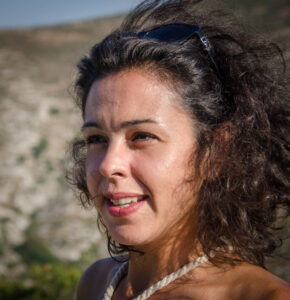
Dr. Emmanouela Apostolaki
I hold a BA in Archaeology & History of Art from the University of Athens, Greece and a MSc in the Analysis of inorganic materials with the use of physico-chemical methods from the University of Sheffield, UK. My Ph.D. explored the dynamics of non-elite households in Late Bronze Age Crete, structured upon a case study and a synthetic examination of published data for the Neopalatial period regarding household form, domestic architecture and the function of domestic space from an anthropological standpoint (“The dynamics of domestic space. Examples of households from the Neopalatial society of Crete”, 2014). I am especially interested in prehistoric urban environments and the complexities of daily life that those entail, seeking to define the various social formations that existed in the Bronze Age and whose practices and interplay kept society in operation. In my research and published work I have tried to throw emphasis on the difficulties of disentangling settlement histories at the field, stressing the need for a multifaceted interpretative lens and for a strong anchorage on empirical evidence, while also I advocate the feasibility of approaching small spatial and temporal scales archaeologically (e.g. the ‘individual’ social unit, the neighbourhood, the life-cycle of one generation) together with abstract notions, such as social solidarity and interdependence. I have worked for several years in the Archaeological Museum of Herakleion, Crete and more recently for the Herakleion Ephorate of Antiquities serving as field and trench supervisor at large-scale rescue excavations. I currently co-direct the publication of the BOAK-Agriana rescue excavations project.
- Role in the project: Data processing in Aegean Bronze Age architecture
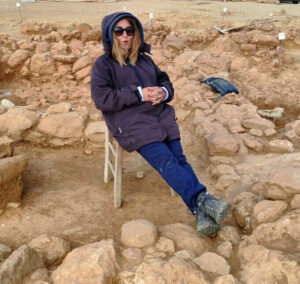
Dr. Thea Messina
My main research interest is the reconstruction of the social structures of ancient societies through an anthropological perspective, applying functional analyses to different classes of the Bronze Age Mediterranean material culture including textile related tools, pottery cooking devices, and architectural remains. I studied Prehistory of the Mediterranean in Catania with an Erasmus in Heidelberg, and after a Bachelor studying tools related to textile production in Sicily, I obtained a Master’s in Archaeology following a dual degree programme with the University of Konya (Turkey), with a thesis on statistical analysis applied to archaeological contexts. In 2017, I obtained a diploma of specialization in “Prehistory and Protohistory of the Aegean and Eastern Mediterranean” at the Italian Archaeological School at Athens (SAIA), with a thesis about the North-Eastern Complex of the Phaistos Palace in the Prepalatial period. I successfully defended my PhD in the University of Catania in 2022, with a thesis focusing on cooking practices in the Bronze Age Mediterranean with a special attention on major island contexts, especially Sicily and Crete. One of the main goals of my doctoral research was to infer levels of social complexity from the specialization of the cooking sets within the different archaeological contexts. I am a member of the Italian Archaeological Mission in Phaistos and Haghia Triada, where I participate to excavations and study campaigns since 2013.
- Role in the project: Data processing in Aegean Bronze Age architecture
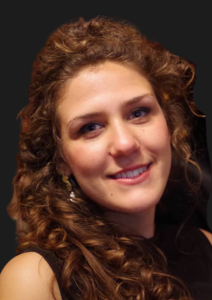
Advisory Board
Prof. Artemis Karnava
- Affiliation: University of Crete
- Area of expertise: Ancient Eastern Mediterranean writing systems and administrative practices
Prof. Çiğdem Maner
- Affiliation: Koç Üniversitesi
- Area of expertise: Bronze Age architecture and societies in the Greek Mainland and Anatolia
Prof. Joseph Maran
- Affiliation: Heidelberg University
- Area of expertise: Bronze Age architecture and societies in the Greek Mainland
Prof. Pietro Militello
- Affiliation: University of Catania
- Area of expertise: Bronze Age architecture and societies in Crete
Em. Prof. Clairy Palyvou
- Affiliation: Aristotle University of Thessaloniki
- Area of expertise: Bronze Age architecture in the Greek Mainland, Crete and the Cyclades
Prof. Todd Whitelaw
- Affiliation: University College London
- Area of expertise: Settlement patterns and socio-political systems in the Bronze Age Eastern Mediterranean
